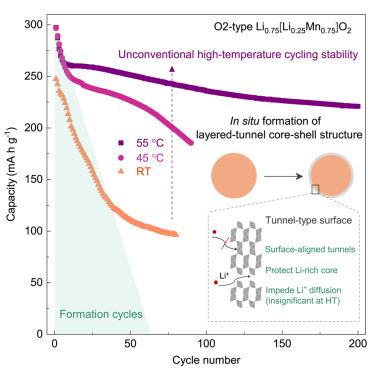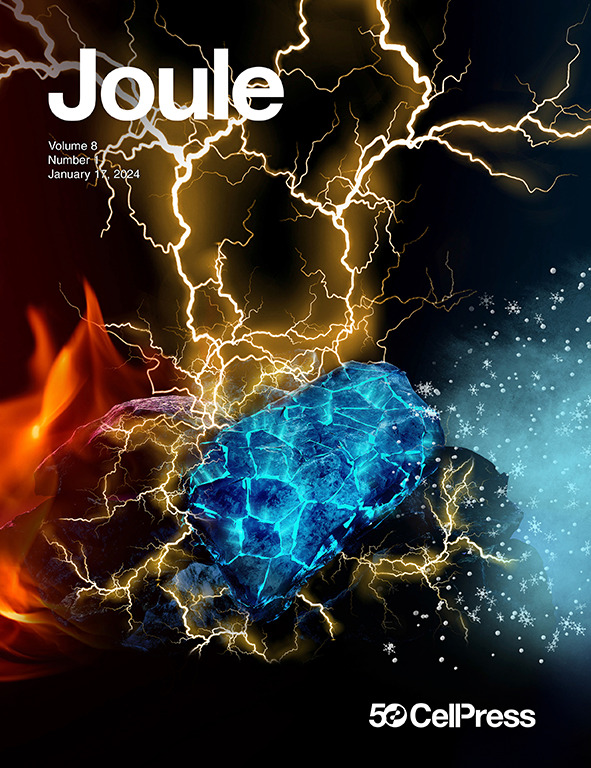Unconventional high-temperature cycling stability of O2-type Li0.75[Li0.25Mn0.75]O2 cathode
IF 35.4
1区 材料科学
Q1 CHEMISTRY, PHYSICAL
引用次数: 0
Abstract
Lithium-rich manganese-based oxides are promising cathode materials for high-energy lithium-ion batteries but suffer from capacity deterioration due to oxygen release, irreversible structural changes, and detrimental secondary reactions—all of which are known to be exacerbated at elevated temperatures, leading to inferior high-temperature cycling performance. Here, we report the discovery of an unconventional temperature-dependent behavior in an O2-type cathode, which exhibits significantly improved cycling stability at an elevated temperature (55°C) compared with room temperature (RT), delivering high capacities of up to 300 mAh g−1. Combined structural and electrochemical analyses reveal that an in situ-formed ramsdellite-like surface layer, with tunnels oriented parallel to the crystallite surface, effectively protects the O-redox activity within the layered core but impedes the Li+ diffusion into and out of the particle at RT. However, Li+ diffusion through this protective surface layer is kinetically unlocked at elevated temperatures, resulting in improved capacity and cycling stability.


O2型Li0.75[Li0.25Mn0.75]O2阴极的非常规高温循环稳定性
富锂锰基氧化物是高能锂离子电池很有前途的正极材料,但由于氧气释放、不可逆的结构变化和有害的二次反应,导致容量下降,所有这些都在高温下加剧,导致高温循环性能下降。在这里,我们报告了在O2型Li0.75[Li0.25Mn0.75]O2Li0.75[Li0.25Mn0.75]O2阴极中发现的一种非常规的温度依赖行为,与室温(RT)相比,该阴极在高温(55°C)下表现出显著改善的循环稳定性,提供高达300 mAh g−1的高容量。结合结构和电化学分析表明,原位形成的ramsdellite-like表面层具有平行于晶体表面的隧道,有效地保护了层状核心内的o -氧化还原活性,但阻碍了Li+在高温下进出颗粒的扩散。然而,在高温下,Li+通过这一保护表面层的扩散被动力学解锁,从而提高了容量和循环稳定性。
本文章由计算机程序翻译,如有差异,请以英文原文为准。
求助全文
约1分钟内获得全文
求助全文
来源期刊

Joule
Energy-General Energy
CiteScore
53.10
自引率
2.00%
发文量
198
期刊介绍:
Joule is a sister journal to Cell that focuses on research, analysis, and ideas related to sustainable energy. It aims to address the global challenge of the need for more sustainable energy solutions. Joule is a forward-looking journal that bridges disciplines and scales of energy research. It connects researchers and analysts working on scientific, technical, economic, policy, and social challenges related to sustainable energy. The journal covers a wide range of energy research, from fundamental laboratory studies on energy conversion and storage to global-level analysis. Joule aims to highlight and amplify the implications, challenges, and opportunities of novel energy research for different groups in the field.
 求助内容:
求助内容: 应助结果提醒方式:
应助结果提醒方式:


